How to Use 7-Zip — Step by Step Free Guide (with Pictures) 7-Zip Download for PC Windows 10/7/8.1 (Official Latest) 7-Zip for macOS — Download Best File Archiver for Mac; 7-Zip Command Line Examples — All Syntaxes Shared Here; Recent Comments. Kriba on 7-Zip for macOS — Download Best File Archiver for Mac. Commands marked. are bash built-in commands. Bash is the default shell, it runs under Darwin the open source core of macOS. In macOS Catalina the default shell will change to zsh and in time this page will be updated to include that. How do I list the contents of a zip along w/ file sizes and compression ratio (or packed size) on osx w/ command line tools? Stack Exchange Network Stack Exchange network consists of 176 Q&A communities including Stack Overflow, the largest, most trusted online community for developers to learn, share their knowledge, and build their careers. The zip command line utility discards metadata such as extended attributes, file flags, and resource forks, which also means that metadata such as tags is lost, and that aliases stop working, because the information in an alias file is stored in a resource fork.
| Click here to return to the 'Create split zip files from the command line' hint |
Mac 7 Zip Command Line
The -s parameter splits the archive into multiple zipped files fine, but how do I unzip them? Using unzip from the command only looks at the very last file in the archive, and when you specify the first file (.z01), it errors out with:
$ unzip bws.z01
Archive: bws.z01
End-of-central-directory signature not found. Either this file is not
a zipfile, or it constitutes one disk of a multi-part archive. In the
latter case the central directory and zipfile comment will be found on
the last disk(s) of this archive.
unzip: cannot find zipfile directory in one of bws.z01 or
bws.z01.zip, and cannot find bws.z01.ZIP, period.
Osx Zip Command Line Recursive
The Unarchiver (free in MAS), unzips the split zip just fine, but hell if I can't find a way to get unzip at the command line to do the same thing.

Osx Zip Command Line Recursive
The Unarchiver (free in MAS), unzips the split zip just fine, but hell if I can't find a way to get unzip at the command line to do the same thing.
Why not create the zip file and then use the split command to make your chunks? Yarn mac os. Those files can simply be concatenated and unzipped.
Mac Zip Command Line Password
You and I could definitely do that, and that is certainly the way I would've gone if I wanted to split up a tgz file. My mom… not so much, especially not on Windows. If she were using a Mac I probably would've gone with a sparse bundle DMG file.
As I mentioned in the OP, the man page for zip explains the difference between that approach and using the split zip method.
Split zip is just one alternative to this problem, and it happens to have built in support on both Windows and OS X.
The rar command line tool can be downloaded as (never ending) trialware at rarlab.com. Unrar is free on all platforms. Usage: 'rar a -m0 -v4700000 archivename filename(s)' where a = add (create archive), -m0 = no compression (-m5 = max compression, not useful for video plus it takes much longer), -v with max size in KB (1000 bytes, append 'k' for size in 1024 bytes: -v4589843k).
Uh, what?
'It appears that OSX 10.8 removed the tar --tape-length flag'
Not really. Our fine friends at Apple have chosen to remind us there are other versions of software beside that provided by GNU. Mac OS X appears to have moved 'tar' to be 'bsdtar' and gnu tar is now 'gnutar'. Actually, it's a symlink. Do 'ls -l /usr/bin/tar' to see.
Try this:
gnutar --tape-length=102400 -cMv --file=tar_archive.{tar,tar-{2.100}} [files to tar]
Note, I would *NOT* change the link to gnutar. There be dragons.
That is very helpful! I was a little taken aback when I found that normal 'tar' didn't have the --tape-length flag, even for historical purposes. Knowing about gnutar is very helpful, thanks for pointing it out!

